When you find scale on your plants, getting rid of them can take some time – but it’s not impossible. I’ve successfully descaled my houseplants, and so can you.
In this post, you’ll learn how to identify them, where they come from, and the best natural and organic methods to get rid of them – FOR GOOD.
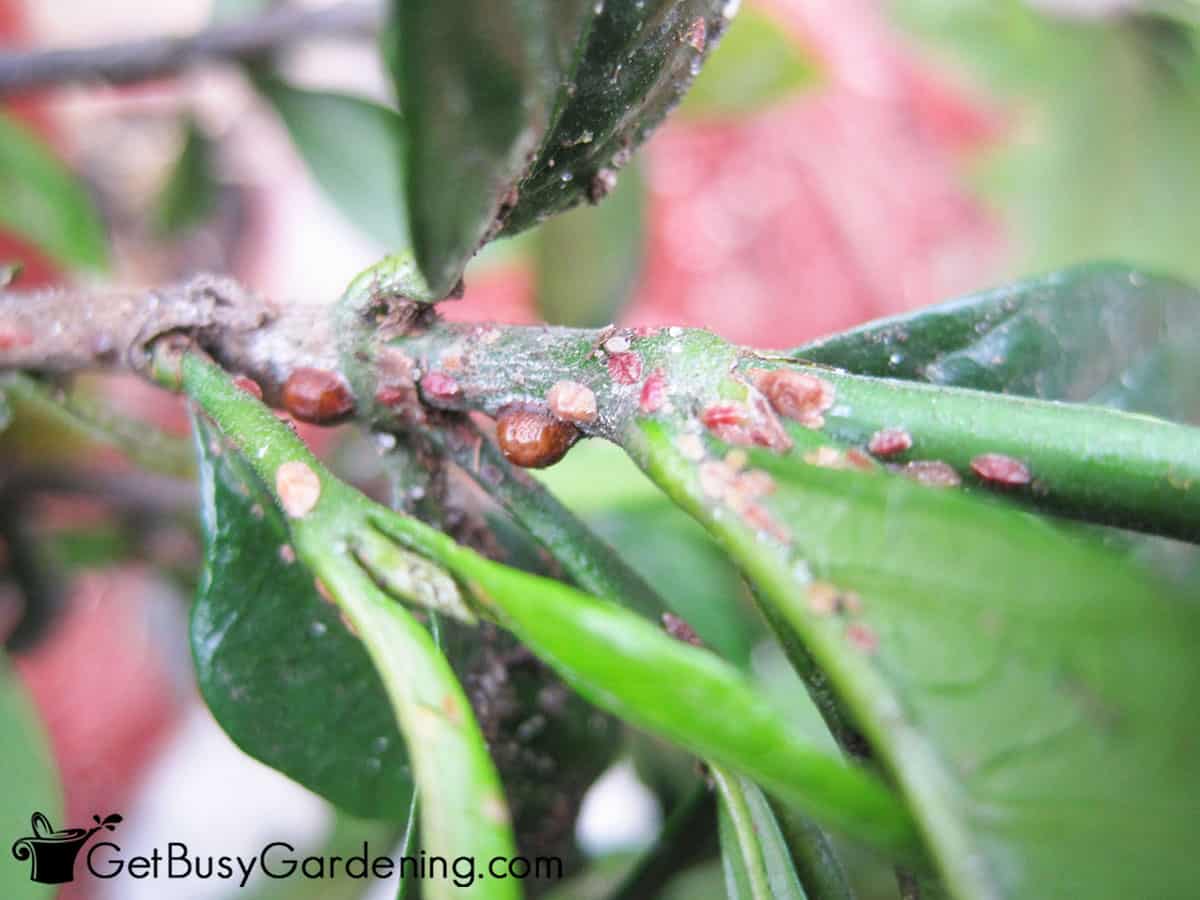
What Are Scale Insects?
Houseplant scale insects suck the sap out of the leaves and stems. This results in stunted or deformed leaf growth, yellowing of the leaves, brown pock marks, and possibly leaf drop.
You can find them almost anywhere on a plant, but they’ll usually be hanging out on the stems and leaf joints, and along the veins of the leaves.
You may also notice sticky leaves on the leaves, on the pot, or around the area where the plant is sitting.
This sticky substance is usually the best way to help with identification if you’re unsure. That’s because as the insects feed, they excrete a sticky residue, which is a common sign of an infestation.
What Do They Look Like?
Scale insects can be very difficult to see. Even if you do notice them, they appear more like a weird growth rather than a bug.
In fact, they look like small brown dots or bumps, and they don’t move. Eek! To me, they look like scabs on a plant (and that’s seriously what I thought they were the first time I saw them, haha).
They can be rounded, oval shaped, or flat, and can range in size from barely visible to large bumps. Their color can range anywhere from brown to tan to white.
Scale likes to cluster, so they are very noticeable once the population gets large. Like I said before, they don’t look like bugs so you probably won’t even notice them until your plant has become infested.
If the bugs on your houseplants are white and fuzzy and look more like mildew, those are mealybugs, and here’s how to get rid of them.
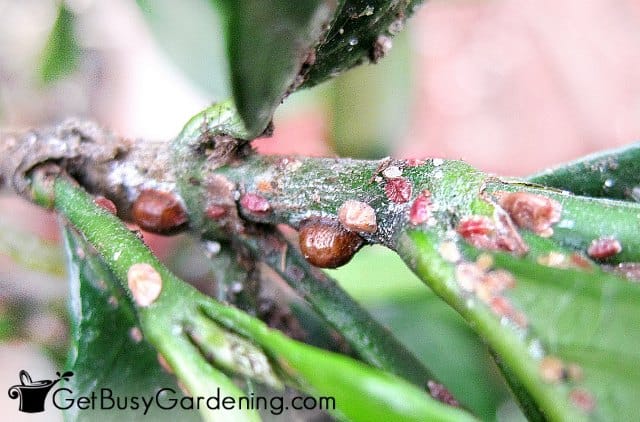
Their Life Cycle
Scale can reproduce very quickly. Their entire cycle takes about 7-10 weeks, and it has several stages.
It takes a few weeks for the eggs to hatch into nymphs (aka crawlers), and then another 6-9 weeks for the crawlers to mature into adults.
The nymphs can move around on a plant or migrate to surrounding ones. Once they find a good place to start feeding, and they mature into adults, they never move again.
The eggs and nymphs are tiny, so it’s easy to understand why most people will never know their houseplant has scale until the population has exploded.
Scale Damage On Plants
Scale insect damage can look like pock marks on plants like succulents and cacti, or it can be something as subtle as brown or yellow leaves.
Thankfully, the damage they cause is not as quick to occur or as devastating as it is with spider mites, but it can still look pretty bad.
If an infestation is left untreated, the plant could eventually die. Although it would take a long time, and a very large population for them to kill a mature indoor plant.
Related Post: How to Get Rid of Fungus Gnats In Houseplants Soil
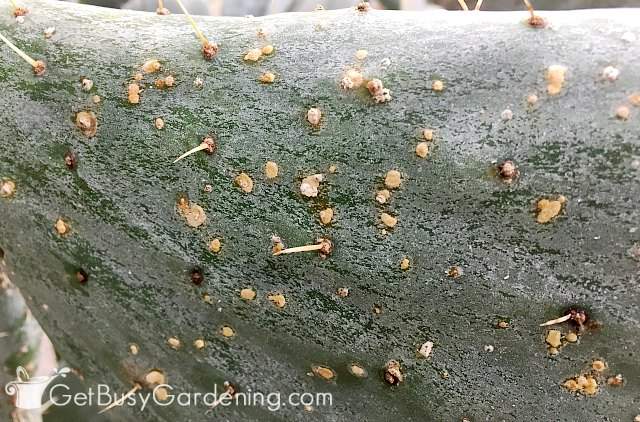
Where Do Scale Bugs Come From?
When you discover scale on your indoor plant, the first question you’ll ask is where the heck did they come from? They’re actually very sneaky, and many times you will never figure out where they came from.
They can come from just about anywhere, so it’s easy to go crazy trying to figure it out. Here are 6 of the most common sources:
- Bringing home a new houseplant from the store
- Using contaminated potting soil
- Reusing a dirty plant pot
- Moving your indoor plants outside during the summer
- Bringing in fresh produce or cut flowers from the garden (or even from the grocery store)
- Leaving a window open – the crawlers are tiny, so they can get through the smallest openings
Read more about all of the places where houseplant bugs can come from here.
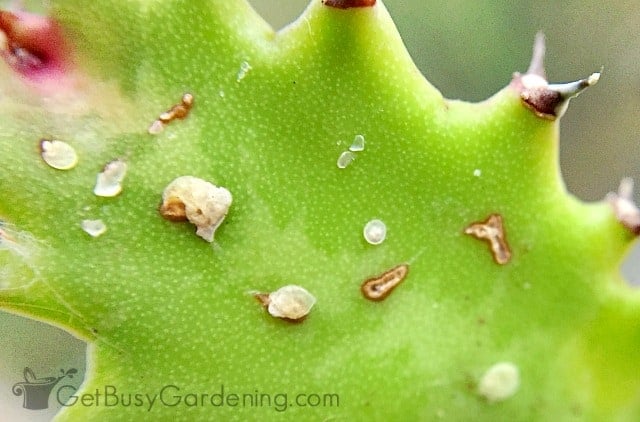
How To Get Rid Of Scale Insects On Houseplants
When you first find scale insects, you should isolate the infested plant and begin treatment immediately.
I don’t recommend using synthetic chemical pesticides. That’s because scale can build up a resistance to them, especially ones they are exposed to on a regular basis. Plus, in most stages of their life cycle, pesticides won’t penetrate their hard outer shell anyway.
Always use natural, organic methods instead. They are not only better for us and our family, they work to kill the bugs, and they can’t build up resistance to them.
You can learn even more about all-natural houseplant pest control remedies here.
Natural Treatment Methods
To help get you started, I’m sharing three of the best natural treatment methods. But before you begin, here are a few of my favorite tips:
- As you work on treating your plants you should check every crevice, especially around the leaf and stem joints and underneath all of the leaves.
- They like to hide, so be sure to check the plant from a bunch of different angles.
- Brush away a little dirt around the base of the stem to see if any are hiding there. It’s not uncommon to find them on the roots.
Rubbing Alcohol
You can use a cotton swab dipped in rubbing alcohol to kill and remove as many of the scale insects as possible. For the rubbing alcohol to be effective, it must come in direct contact with the bugs.
Some of the adults with the hardest outer shells might be stuck on there good. So you may need to pry some of them off with your fingernail.
This method works very well for small infestations. It also helps to eliminate as many of the large insects as you can so that you can gain the upper hand.

Homemade Insecticide Soap
You could buy organic insecticidal soap, or you can make your own homemade spray. My recipe is 1 teaspoon of mild liquid soap per 1 liter of water.
Either way, spray it directly on the bugs and on the leaves. If your plant is small, you can bring it to the sink or shower and wash the leaves, gently removing as many of the bugs as you can.
Keep in mind that some soaps can be damaging, so it’s best to test any type of spray on a couple leaves before you spray the entire plant.
Neem Oil
Neem oil is a natural insecticide, and it’s very effective for treating scale. An added bonus is that it has a residual effect to help with future prevention too.
It works best when you douse your plant, and continue using it until all signs of the bugs are gone. Learn more about neem oil and how to use it here.
More Tips For Getting Rid Of Scale On Plants
You can’t treat a plant once and expect to get rid of all of the scale, you need to be persistent. Keep checking on them a few times a week, and remove any new bugs that you see. Here are a few additional tips.
1. Replace the top layer of soil – Bugs can hide in the soil, so if a plant is plagued by recurring infestations, you could try removing the top inch and replacing it with fresh potting soil.
2. Clean surrounding area – Crawlers can leave the plant and then come back to infest it again later. So remove it from the area and clean any crevices where the pests could be hiding. Be sure to check around the outside lip and inside edges of the pot and drip tray, and the bottom of the pot for hiding insects.
3. Prune heavily infested leaves – Trim off the most heavily infested leaves and toss them into the trash (outside of your home). Never trim all the leaves off though.
4. Sanitize the pot – If you decide to repot a plant after treating it, be sure to sterilize the container before reusing it. Insects can hide on the edges, bottom, or the rim and easily infest the next plant. Scrub the pot with soapy water, or better yet, put it in the dishwasher to sterilize it.
5. Continue treating your plant – Use a neem oil regularly as a preventative measure until you are sure your plant is scale-free.
Getting rid of scale on your indoor plants can be challenging, but don’t give up! If you’re diligent, and follow my instructions and tips above, you will win the fight!
If you’re struggling with bugs on your indoor plants, my Houseplant Pest Control eBook is for you! It will show you exactly how to get rid of bugs naturally, including identification, home remedies, how to keep them from EVER coming back, and much more. Download your copy today!
More About Houseplant Pests
- How To Debug Plants Before Bringing Them Indoors
- How To Get Rid Of Whiteflies On Indoor Plants
- How To Get Rid Of Bugs On Houseplants
- How To Get Rid Of Aphids On Houseplants
- How To Get Rid Of Thrips On Houseplants
How do you get rid of scale on houseplants? Share your tips in the comments below.
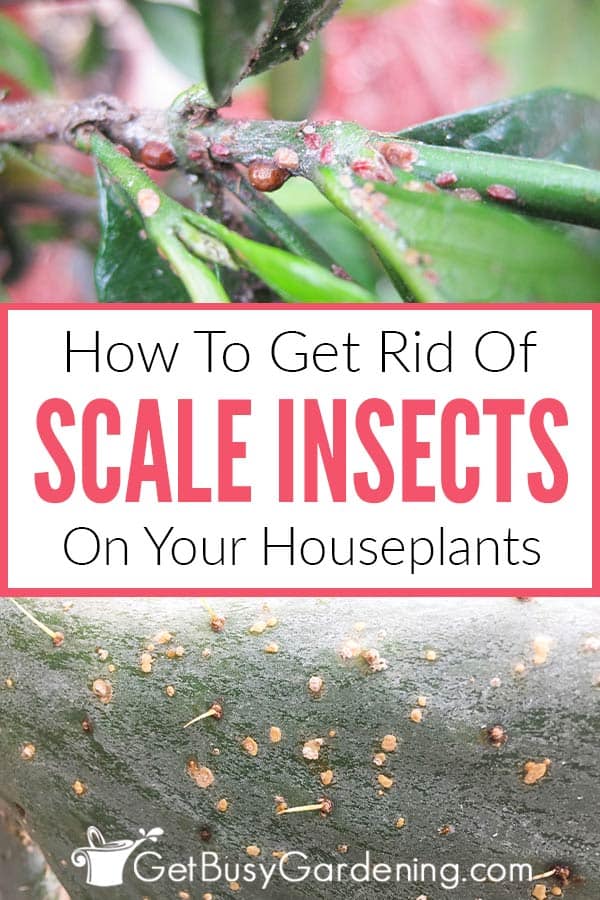
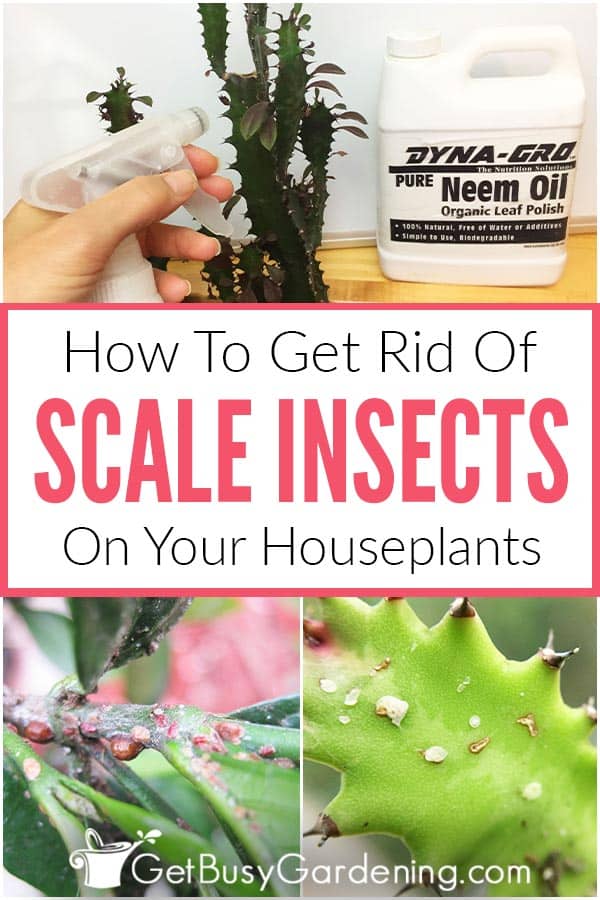

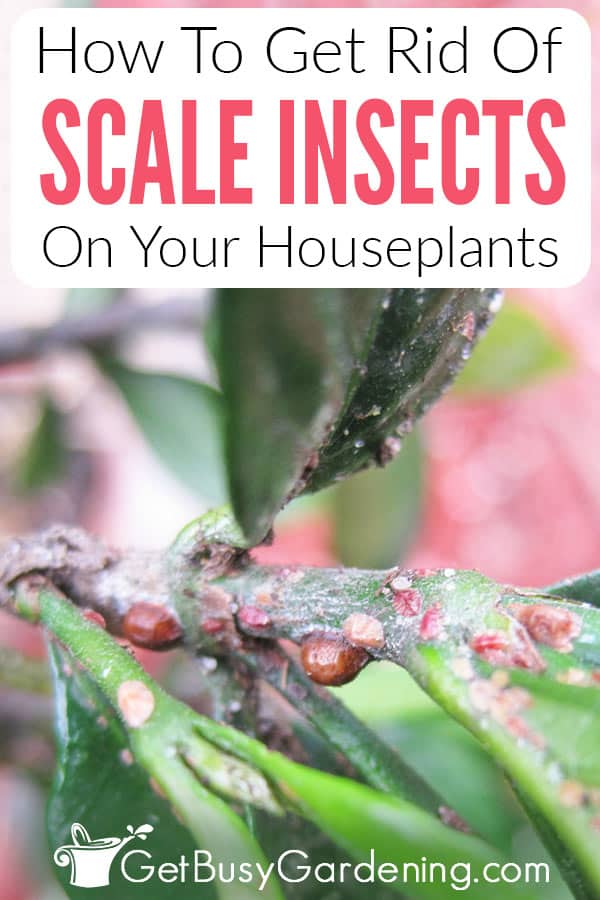
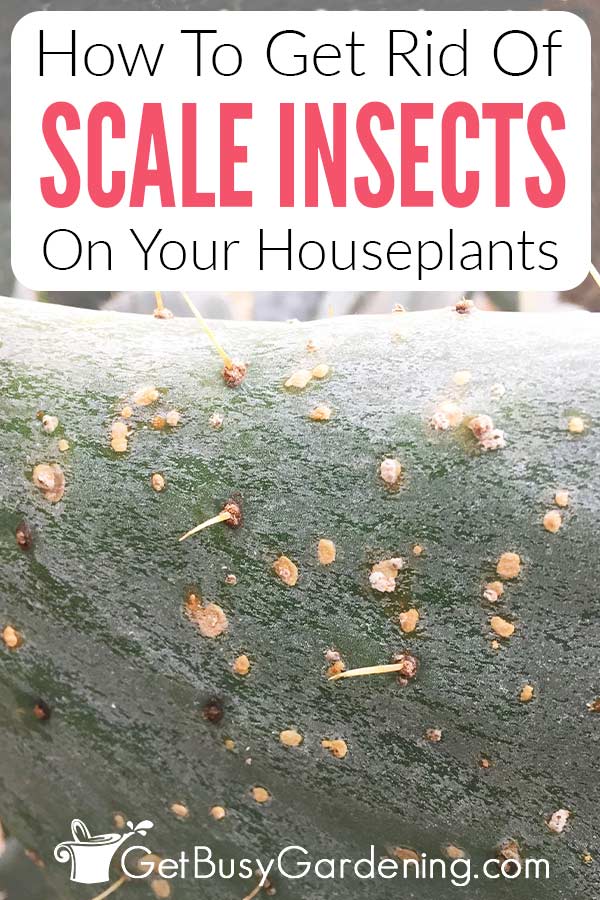
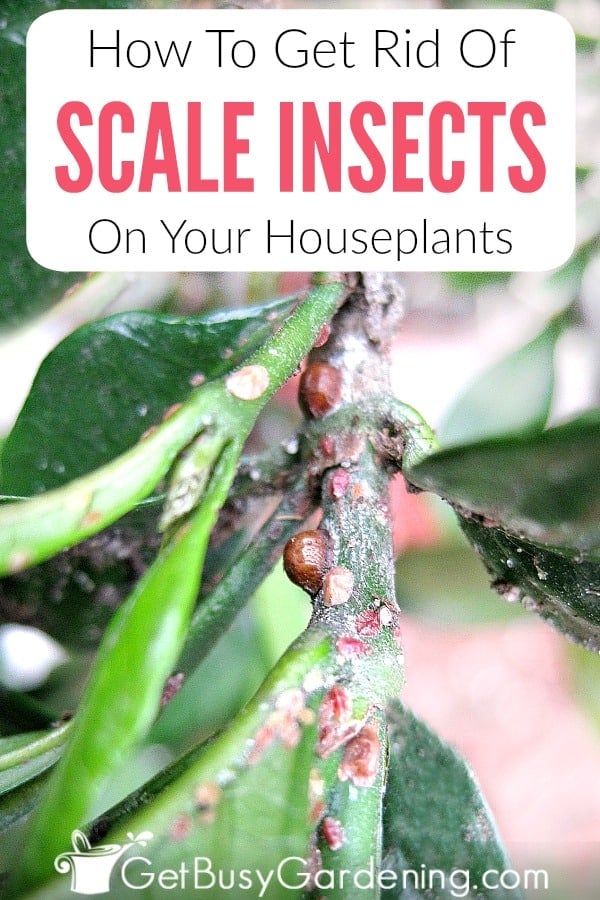

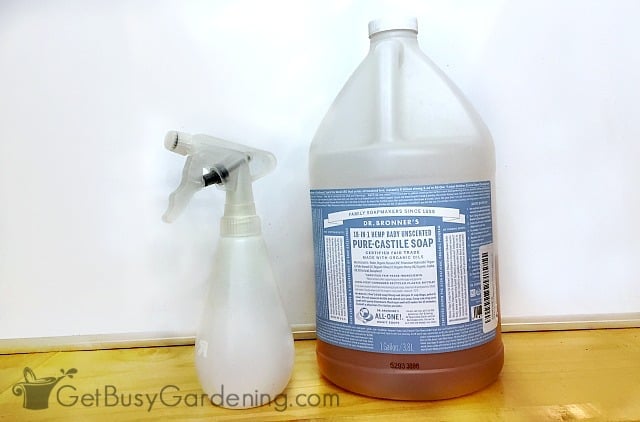
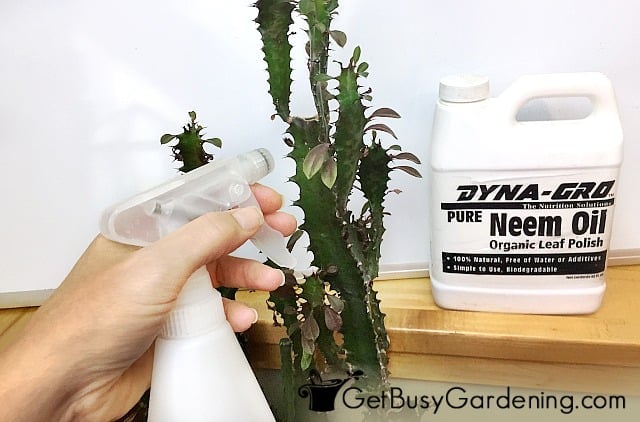
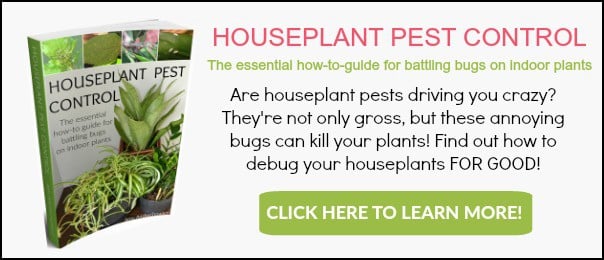

Phil kyryluk says
I bought a sago palm from Home Depot many years ago..It had scales…and now most of my plants do,especially all 5 of my spiders and all of my orchids. Dish soap helps but does not eliminate them.
Amy Andrychowicz says
Oh no, sorry to hear you’re fighting scale on your houseplants! Have you tried using neem oil? To get rid of a large infestation, you’ll need to be persistent and use a combo of methods. I recommend using rubbing alcohol on a cotton swab/cotton ball to clean off as many as you can see, then washing thee leaves with soapy water, rinsing them off, and dousing with neem oil (don’t rinse after that). Once your plants are clean, continue using rubbing alcohol to remove them as more bugs appear, and spray your plants with neem oil monthly until you no longer find anymore scale. Good luck!
Lea says
I’ve been treating my large lemon tree for scale for over a year with no signs of improvement. Several times now I have taken a week and did nothing but laboriously scrub every leaf and branch from the main trunk out starting low and working up and working my way around. It was EXHAUSTING… and although it would look better for a few weeks, within a month I would see new infestation spots starting. Neem oil hasn’t helped… NOTHING has helped…. I may call and arborist and have him skelatonize the poor thing once it’s done with with it’s current fruit harvest. For reference this tree is about 9-10 ft tall with a 14 ft circumstance…. It can’t really be moved as it’s planted into the floor of my greenhouse. I was wondering about heat treatment? Are scale tempature sensitive? I recently had a coworker bring home bedbugs from a vacation trip and they treated her house with heat to kill the insects….
Amy Andrychowicz says
Oh no, so sorry to hear that your plant is infested with scale, they can be very difficult to get rid of for sure – especially on such a large tree. I definitely stand by my recommendation for neem oil. It’s something that will take some time, as the bugs have to feed on the treated leaves before they will die, and there are usually MANY generations of scale present at one time. So you have to continue to treat the plant on a regular basis before you can get rid of them, it’s definitely not a one (or two or three) and done type of treatment. You can also try using neem oil as a systemic in addition to spraying it on the leaves. Here’s my tutorial on how to use neem oil to effectively get rid of bugs on plants to give you more details. But not matter what product(s)/technique(s) you choose to use, it will take time to get rid of a heavy scale infestation on a large plant, there’s no getting around that. 🙁 You could also try releasing ladybugs or some other type of predatory insect(s) into your greenhouse to help you out. That is a very common practice for greenhouse owners, even large-scale commercial ones do that. Good luck!
Yamile says
Do you use insecticidal soap weekly (whether DIY neem inseciticidal or the sprays you can purchase)?
Amy Andrychowicz says
Insecticidal soap has no residual effect, and will only kill the scale and their eggs on contact. So you should spray it weekly as long as you see bugs. On the other hand, neem oil does have a residual effect, so you can spray it on every few weeks.
Safi says
Can I use the Need Oil on a Naval Orange Tree? When it produces oranges I do not want them to be contaminated with chemicle.
Amy Andrychowicz says
Always check the package on the specific product you buy to make sure it’s safe to use on food crops.
Rachel Miracle says
I have an ivy tree that I lost the battle on with scale insects. Is there anything I can do to see if there is any life left at all? If I trim off all the dead, replace soil and fertilize is there any chance I can bring it back? Thank you!
Amy Andrychowicz says
Oh no, sorry to hear your plant lost its battle with scale. I’m not sure if a tree ivy would grow back from the roots after it has died back to the soil. The best thing you can do is to leave it alone, maintain the proper watering, and hope it comes back after a few weeks or so. Definitely do NOT repot or fertilize it. Those will only further stress the plant, and likely kill it for sure. Good luck, I’ll keep my fingers crossed for you!
Hailey Talbot-Tittle says
Hi there, I have been treating an 8 foot indoor ficus for scale for around 6 months, repeatedly cleaning it, or spraying it with alcohol but I’m not having much luck. It’s a really laborious task to wipe individual leaves off of something so large which is why parts of it are getting missed. Do you have any recommendations?
Thanks
Amy Andrychowicz says
Have you tried neem oil yet? It’s very effective to get rid of them, and has a residual effect so it’s not so much work. Here’s more info and how to use it.
Lynn Payne says
I guess it got infected when I placed it outside for the summer. How do I prevent that from happening again? Never take it outside?
Thank you so much for your information,
Lynn
Amy Andrychowicz says
Oh no, I’m so sorry to hear that your plant has scale, that’s no fun! Never taking it outside is definitely one possibility. But if you want to keep putting it outside for the summer, debugging it before bringing it back inside is essential. Since I started doing that 10 years or so ago, I’ve not had one pest infestation on my indoor plants. Here’s how to do it.
Lynn Payne says
Thank you for posting all of the comments regarding scale, I feel that I’m not alone in this battle!
I have been treating my potted lemon tree for several weeks swabing leaves with alcohol, spraying the solution and using Neem oil. I have it quarantined. It has lost most of its leaves. I will continue to treat weekly in hopes that it will come back. Should I prune it? How long do these critters live without a host plant? I’ve cleaned the area where the plant was living. I have another beautiful plant in that room and it appears healthy. I want to bring the lemon tree back to that room because it gets the best light. Is there a safe distance that I could place it from the other plant?
Thanks for your help!
Amy Andrychowicz says
Oh no, sorry to hear you’re dealing with a scale infestation, that is no fun. I would wait to prune it back until the plant starts to recover. Scale can live without a host for several weeks. I always try to wait a few months before putting any plants back in the spot to be safe. Definitely keep it several feet away from your other plants, the farther the better. Also, make sure to wash your hands and tools with soap and water after handling the infested plant. Good luck!
monique says
Hi Amy – I was recently gifted an umbrella plant but very quickly saw that something was wrong. After closer inspection I realized the sticky honeydew substance was likely soft scale. There were also all these brown and orange spots all over it. So I left it in the garage intending to throw it away. However, my husband unknowingly brought the plant into the house for ~30 mins and placed it roughly 4 ft from the rest of our plants (before I quickly moved it back outside!). Now I’m HORRIFIED that scale could have traveled to my other house plants in that time. Do you know how quickly soft scale can spread/travel? Is it possible scale nymphs could have migrated to my other plants in that timing?
Also – do you know if scale can jump onto/be transported by clothing? After moving the plant back outside I thoroughly washed my hands (twice) but wasn’t sure if there was a threat of it getting on my clothes and being carried to my other plants that way…
Any advice would be super helpful! I’m sadly very paranoid now of a scale infestation!
Amy Andrychowicz says
Oh no, sorry to hear your plant is infested with scale! The good news is that they don’t fly, and can only crawl during the nymph stage. However some may have dropped off the plant, and could eventually make their way to your others. They don’t jump, but they certainly could get onto your clothing if you brush up against an infested plant. The best thing you can do is thoroughly clean the area where the plant was sitting with rubbing alcohol and/or soapy water. Then keep a very close eye on your other plants for signs of infestation. The faster you spot any new scale insects and start treating them, the better chance you have to get rid of them the fastest.
monique says
Thank you Amy!! Will do that now – appreciate it!
Amy Andrychowicz says
You’re welcome!
Miki Bloom says
I have a gold fish plant that is 35 years old. I recently moved to Michigan from California during the winter months. this plant made the move. I knew I had a few scale, a coexisting life for years. The move to Michigan seems to have given these little buggers to go hog wild on my plant. I have sap everywhere, the plant is isolated and I have tried everything. It is a rather large plant and it is not really possible to try and clean each leaf and stem. I want to throw it away, but it has been part of me for a long time. Do you have any recommendations?
Amy Andrychowicz says
Oh no, so sorry to hear your plant is infested with scale! If you had it outside in CA and then moved it indoors in MI, that would explain the explosion in their population (there are natural predators outside that can help keep their populations down). I would try debugging it as I describe here, and then begin treating it with neem oil right after. It may take some time to get rid of them all together, and you may need to continue treating it with neem indefinitely to keep the scale from coming back, but this process usually works great.
Daniel says
Just came here to say thank you for the information and that I hate scale bugs. They won’t leave my potted lemon tree alone and after last year’s constant battle with them, and their full blown return now, I’m feeling defeated. I do love that potted lemon tree though. I’ll keep trying for a bit.
Amy Andrychowicz says
You’re welcome. Bummer to hear that your lemon tree has recurring problems with scale. Good luck getting rid of them, I hope you will be successful this time. Just remember to be persistent, and keep treating the plant even after all signs of the bugs are gone. Then keep a close eye on them for signs of re-infestation.
jay says
hi amy
jay from chicago here.
i tried the homemade concoctions but nothing seemed to work. all of the zz’s have faded and i’m at throwing them all away. too bad. i have also tried to disinfect the leftover potting soil from plants i discarded, i have not used the disinfected soil yet. my question is: can i reuse this disinfected soil in the future? i plan on resuming with new plants. is disinfected potting soil trustworthy? thank you
Amy Andrychowicz says
I do no recommend trying to disinfect the soil yourself for reuse. For me, it’s too risky. There’s no way to tell if you killed all of the scale insects that could be in the soil waiting to re-infest your plant. I recommend always buying fresh, sterile potting soil from the store, and discarding the stuff that’s already been used.
Kathleen Hendrickson says
I appreciate your advice. I thought I had succeeded in eradicating the scale on my ornamental Orange tree last summer. now they are back again! my tree is 26 years old and in a heavy 15-in pot so I dread cleaning the rim of the pot before it is warm enough to move the tree to my neck. I have been picking off the scale from the leaves and washing them off my fingers in a bucket of water. when I try to spray the underside of the leaves with neem oil the leaves fall off. when I am not looking more leaves are falling. is this hopeless?
Amy Andrychowicz says
Bummer, sorry to hear that your plant is infested with scale again. That is so frustrating. They can be very difficult to get rid of, especially on large plants. I would take a look at where you’ve been putting it when you move it inside for the winter. Scale can live without a host plant for a long time. So, if you always put it in the same spot, then that could be why your plant is re-infested. Were you able to successfully treat the plant with neem oil when you got rid of the scale infestation last time? If so, then the leaves may be falling off because you just moved the plant, or it may be dropping the most heavily infested leaves. I would try using an alcohol-soaked cotton swab to remove as many of the bugs as you can, and let it get used to being outside before spraying it again. Once it’s used to being outside again, then I would try spraying a few leaves again to see if that causes them to drop. Good luck!
Kathleen Hendrickson says
how should I treat the table it sits on to kill any scale living on the table?
Amy Andrychowicz says
I use a cotton swab soaked in rubbing alcohol to wipe down the area right after moving the plant outside. Then I will do it again a few more times during the summer to make sure I got them all. Make sure you also wipe down any crevices, as well as the sides, legs, and underneath the table too. Scale are excellent hiders, and the babies are so tiny you might not even see them. When you move your plant back indoors this fall, check on it every few days, and closely inspect for any signs of a new scale infestation. The faster you can get on top of it, the better! Good luck!
Debby sinkovic says
I just found scale on my beautiful ficus tree. I just bought neem oil and I will spray it, do I then have to pick the scale off of each leaf or just leave it. I appreciate any advice. Thank you!
Amy Andrychowicz says
It would be best and work much faster if you could remove the scale insects from the leaves, or as many as you can. I know that can be a huge a tedious job though, especially for large plants. I personally will remove the largest ones I see before treating the plant with my neem spray. I do this each time I treat the plant. It will be impossible to remove every single one of them (they start off really small), so get as many as you can each time. Slowly you will start to see less and less of them, and you’ll know it’s working! The most important thing is to be persistent. Good luck!
Jay morrissey says
Hello,
I’m jay m. From chicago. I bought a zz and snake plant a few years ago, and they seemed to have done so well.then i came up with a brilliant idea. Since they were getting so big, i might as well split them up and get more zz plants to freshen the air in my condo. Well, i decided this at the end of the year.. probably not good.
I split the zz at the rhizomes, it split up easy. It was packing the pot tight.
I got about 8 small plants out of the division. Some just one or two leaves on a stem, three had a small amount of stems together.
Well, its been a few months now, and some did not make it at all, and some are trying to hang on. I have the three big subdivisions still, and smaller single stems and then i tried water propagating, soil propagating and this mostly failed.
Here’s my question: on the stronger larger multi stem mothers, i have brown holes and scale? And horizontal striations at the union of the leaves and stems. It doesnt really look like scale. I started using a homemade concoction today. Alcohol, soap, and vegetable oil. There are small round holes, striations on the stems, and brown , almost cut marks on the leaves. Is this really scale or do i have a different pest or disease?
Please help! It doesnt seem that these websites want to help unless you buy something. I even became a sustaining member on a monthly basis on one ladies site!
Ill pay if i can get some reliable help. I really like these plants and want more of them. I’m completely new at this.
Thank you,
Jay morrissey- chicago
Amy Andrychowicz says
Scale insects don’t eat or cut holes into plant stems or leaves. They suck the sap out them them, leaving pock marks or brown spots. It doesn’t sound to me like your plant has scale. It could be thrips, but they don’t normally bite into plants either. I would keep a close eye on the affected stems to see if you can spot any bugs. But I have a hunch that it may be caused by some other issue. ZZ plants love to be pot-bound, so it may be suffering from transplant shock. Also, check the soil to make sure you aren’t overwatering. They hate soggy soil. Let it dry between waterings, then give it a deep drink, making sure the excess drains fully from the pot – never let it soak in water. Hope this helps! You can always post a photo on my Facebook page, and I’ll take a look. Good luck!
jay says
thanks amy!
i bought the “getting rid of pests” ebook, and am looking forward to eradicating pests that may come along! i bought as a guest.
the brown marks i have talking about, horizontal striations at the meeting of stems and leaves and some in general on the stalks-could they be normal? “stretch marks”? they are not bumps like scales. you mentioned they might be some else, any ideas?
like the site, thanks!
jay m chicago
Amy Andrychowicz says
You’re welcome, and thanks for buying my eBook. 🙂 I took a look at the photos you posted to my Facebook page, and it looks like scars from some kind of trauma. Maybe they were rubbed up against something, or got damaged when you divided them. I wouldn’t worry about it. Once the plant gets bigger, you can just prune off the damaged stems.
Nicole Hawkins says
Scale first showed up in my propagation window when I brought infested cuttings home. Unfortunately I was not able to contain them there.
They absolutely do infest roots. And roots of established plants all the way down to the bottom of a 6″ pot. Or may be up from the bottom? Regardless, they especially like spider plant roots with all their fleshy goodness. Best attack I’ve found is to de-pot the plant. Scrape the scale off the roots. Remove many/most roots. Trash the soil. Sanitize the pot. Put the plant back in a propation vessel so it can regrow roots before being repotted. Expect to de-scale the whole plant, roots and all at least 3 times before they stop showing back up.
I also spray with a combo of alcohol, neem oil, dishwasher rinse agent (doesn’t get as sudsy) and water. I try to spray every 3-ish days. Recently found a recipe for canola white oil, going to try that as itight have better staying power.
I’ve lost all succulents except my grandmother’s african milk tree. That is one tough sucker! It’s actually corked over the top of the bugs in some areas. I didn’t think it had any for way too long because it didn’t seem affected and I’ve found that he is one plant that most definitely benefits from my benign neglect. Now I’m digging some out and piercing some shells with a needle. And rubbing/scraping any new ones off as they show up, which is 20 or so a day.
Recently ID’d root aphids in the baby hoya pot. So when it rains it pours. These guys are not affected by neem oil. I’ve got video of them playing in it after I sprayed it strait on them. Alcohol does at least stun them. But all the plants in that window are probably trash bound.
Sigh. Thanks for letting me vent. I think I’m going to let all the plants rest as best they can for a week or two and then try a systemic insecticide. Can’t really hurt anything at this point!
Amy Andrychowicz says
Oh bummer, sorry to hear about your large scale infestation! Yes, neem oil does not kill the bugs on contact. It kills them when they ingest it after feeding on the treated leaves. So it takes a few weeks to notice a difference when using neem oil alone. I always mix mine with soap, which will kill the bugs on contact, and speed up the process. I highly recommend it, and it does have a residual effect. It’s highly effective, but you have to be persistent. For an infestation of your size, it will take months of consistent treatments to get rid of all of the scale. Here’s more information about it… How To Use Neem Oil Insecticide On Houseplants.